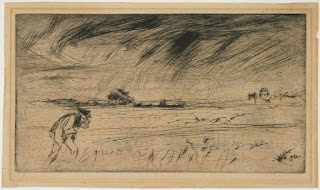James Mc Neil Whistler (1834 -1903) - Nocturne, 1875-77
I paid a visit to the Fitzwilliam Museum, Cambridge, whilst on business in that fair city to see Whistler & Nature, an exhibition that purports to show the impact of landscape on Whistler's art, and his impact, in turn, on British landscape painting. I don't believe the curators have really succeeded in this respect, as the show doesn't have nearly enough important examples of his famed landscape paintings such as the celebrated Nocturnes to lend the exhibition a sense of weight or gravitas. Much of the work shown here comes from the Hunterian Art Gallery collection of Whistler's work and the Fitzwilliam's own holdings. The exhibition relies far too heavily on his etchings of various landscapes, but mainly riverscapes of the Thames and Venice's canals. Apart from the Nocturne above, the painted examples of Whistler's lanscapes included are few and quite slight, being either just preliminary sketches or unfinished works. The figure (set for the most part in interiors rather than in landscape), in Whistler's work, also features rather too prominently in this exhibition too for it to be taken seriously as an investigation into the connection between his painting and nature. This said, the etchings included here are beautifully executed with accomplished draughtsmanship and line work. They are very evocative of place, especially those from his visit to Venice. The exhibition also investigates the influence of the then popular vogue for all things Japanese - Japonisme - on Whistler and other artists of the period. There are some examples of Japanese woodcut prints which proved to very influential in terms of composition and cropping to Whistler and other European artists of the period. I especially enjoyed seeing first-hand here the sheet of drawings in which Whistler developed his famed distinctively stylish butterfly signature (penultimate image below), which I created a post about last year, and which you can read more about (here).
Battersea Reach from Lindsey Houses, 1864-71
Sketch for the Balcony, 1867-70
Cliffs and Breakers, 1884
The Shore, Pourville, 1899
The Bathing Posts, Brittany, 1893
St Ives, 1884
Utagawa Hiroshige (1797-1858)
Clearing Weather at Shibaura from Eight Views of the Edo Environs, 1838
The Storm, 1861
Greenwich Park, 1859
Pensioner, Greenwich Park, 1859
The Traghetto, (No.2), 1880
Nocturne, Furnace, 1880
Nocturne, Palaces, 1880
The Balcony, 1879-80
Black Lion Wharf, 1859
Thames Warehouses, 1859
Billingsgate, 1859
The Pool, 1861
La Sylphide, 1896
Torii Kiyonaga (1752-1815) - Winter Scene, 1784/1795
Four Ladies in Japanese Costume, 1870-3
Two Nudes Reclining on a Terrace, 1867-69
Study of a Standing Woman Seen From Behind
Draped Figure Seated, 1800
The Sisters, 1894-5
The Music Room, 1859
Little Arthur, 1858
Butterflies, c.1869
Portrait of Whistler with a Hat, 1859
Whistler & Nature
until 17th March
The Fitzwilliam Museum
Trumpington Street
Cambridge
CB2 1RB
























































































